Photosynthesis is a chemical process where energy poor molecules (CO2 and H2O) are converted to energy rich molecules (C6H12O6) with the energy to synthesize the energy rich molecule coming from light. The overall equation is:
This equation looks like the opposite of cellular respiration, but the actual reactions are much different. Read behavioral objectives 27-29 and study the pages indicated by E-16 in the text. Just like cellular respiration is divided into sets of reactions - (glycolysis, Kreb, etc.), photosynthesis is divided into sets of reactions: light reactions and dark reactions. During the light reactions light energy is transferred to biological energy -- ATP and NADPH + H. Note that it is NADPH + H and not NADH + H. Where did you encounter NADH+H?
To absorb the proper light waves (red and blue), the green pigment chlorophyll is required. During this process ATP and NADPH + H are formed and HOH is split, forming molecular oxygen. The energy (ATP and NADPH + H) formed during these sets of reactions is used during the dark reactions (carbon-fixing reactions) to reduce CO2 into C6H12O6 glucose. Two types of plants that have evolved different patterns of carbon-fixing reactions are C3 and C4 plants.
Photosynthesis is a complex system involving small parts of cell organelles and chemical reactions. Since it can not be directly observed the details of this process were determined by a system called a closed box.
There are many examples of closed box systems. Atoms are closed boxes because they can never be directly observed. The interior of the earth, the gene, and the operation of a leaf are all closed box systems because scientists can never directly observe what is happening inside these systems.
Click the items which are currently closed boxes.
- a. the surface of the moon
- b. the working of the human brain
- c. the interior of a car engine
- d. the functioning of cell cytoplasm
- e. the electron
- f. the bones of the body
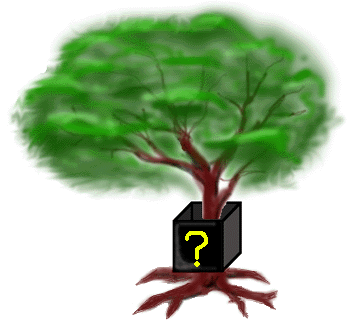
Information about the functioning of plants began to unfold in 1772 with the observations of Joseph Priestley. Priestley knew that a mouse placed in an enclosed glass jar would die after a period of time. A mouse placed in a jar with air left from the burning of a candle died much more quickly. According to Priestley, the burning candle made the air in the jar "stale."
Using growing plants, Priestley discovered how to improve the air in the jar. He found that mice lived a longer time when placed in a container with a growing plant. The plant "restored" the stale air and replaced it with fresh air. Here is his report:
"I have been so happy as by accident to hit upon a method of restoring air which has been injured by the burning of candles and to have discovered at least one of the restoratives which Nature employs for this purpose. It is vegetation."Priestley made his discovery by (click one): If we think of the plant as a closed box system, Priestley "shook the box" to find out something about what happens inside the box. We can illustrate Priestley's findings.
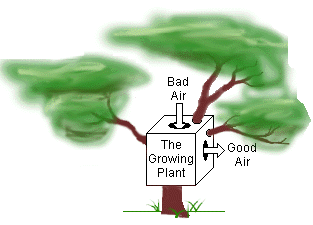 Fresh
air in, stale air out. Priestley, as a scientist, took the first step toward
understanding the mechanism for what was happening inside of the plant
system.
Fresh
air in, stale air out. Priestley, as a scientist, took the first step toward
understanding the mechanism for what was happening inside of the plant
system.
The element in air that is essential to keep a candle burning and animals breathing is oxygen. The "injured" air that Priestley wrote about, then, is air that is deficient in oxygen. When Priestley discovered that vegetation would restore this injured air, he had discovered the capacity of vegetation to (click one):
- a. produce oxygen
- b. consume oxygen
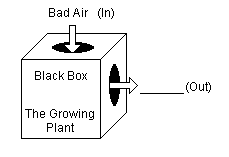 Here is
an illustration of the plant as a closed box. Think about what you would
label the arrow coming out of the box.
Here is
an illustration of the plant as a closed box. Think about what you would
label the arrow coming out of the box.
The best label for the arrow coming out of the box would be "oxygen".
Several years later, the next major step in the investigation of the process of plant growth was reported by a Dutch physician, Jan Ingenhousz. Here is a short statement from his report:
"I found that this operation of the plants is more or less brisk in proportion to the clearness of the day and the exposing of the plants; diminishing towards the close of the day, and ceases entirely at sunset."
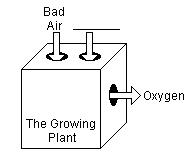 Ingenhousz
learned a requirement for the operation of the system -- light or
light energy. Without an input of light energy, the plant could not produce
oxygen. What would you label this diagram to include Ingenhousz's important
contribution?
Ingenhousz
learned a requirement for the operation of the system -- light or
light energy. Without an input of light energy, the plant could not produce
oxygen. What would you label this diagram to include Ingenhousz's important
contribution?
"Light" would be the most correct label for the diagram.
The discovery that light is required for the process which results in plant growth led to the naming of the process photosynthesis. Photo refers to light and synthesis refers to the process of making plant material. Therefore, photosynthesis literally means "making plants using light."
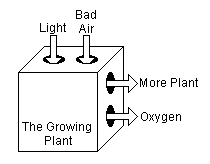 The production
of more plant by the photosynthetic process can be represented on the closed
box diagram by the following addition:
The production
of more plant by the photosynthetic process can be represented on the closed
box diagram by the following addition:
In investigating the nature of this "plant-making" process, Ingenhousz made another important observation. He stated, "I found that... this office is not performed by the whole plant, but only by the leaves and the green stalks."
Suppose you performed experiments with each of the plant materials listed below. Click those which you would expect to carry out photosynthesis.
- a.leaves on a tree during summer
- b.the bark of a tree during summer
- c.the red and gold leaves on a tree during autumn
- d.a rose petal during summer
- e.the green stalk of a tomato plant
- f. the green leaves of an evergreen in winter
Scientists became interested in the question of what gases are taken in and given off by plants during photosynthesis. The following experiment was performed:
- Step 1: The types of gases within a bell jar containing a plant were
- carefully measured.
- Step 2: The plant was allowed to remain in the bell jar for a week under a
- bright light.
- Step 3: The gases within the jar were measured again.
| Gas at Start of Experiment | Gas at End of Experiment | |
| nitrogen |
|
|
| oxygen |
|
|
| argon |
|
|
| carbon dioxide |
|
|
| rare gases |
|
|
- a. What gas did the plant take in?
- b. What gas did the plant give off?
- c. What gases did the plant seem not to take in or give off?
(nitrogen/oxygen/argon/carbon dioxide/rare gases)
(nitrogen/oxygen/argon/carbon dioxide/rare gases)
(nitrogen/oxygen/argon/carbon dioxide/rare gases)
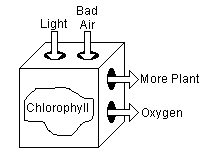 . The bell
jar experiment further verifies Priestley's previous conclusions that plants
produce oxygen. It also provides data for modification of the closed box
model. Examine the data table on the bell jar experiment carefully. Which
one of the labels on the following illustration of the black box should
be changed and how to make it a more accurate description of what is happening
in photosynthesis.
. The bell
jar experiment further verifies Priestley's previous conclusions that plants
produce oxygen. It also provides data for modification of the closed box
model. Examine the data table on the bell jar experiment carefully. Which
one of the labels on the following illustration of the black box should
be changed and how to make it a more accurate description of what is happening
in photosynthesis.
Stale air should be changed to carbon dioxide.
You will recall from Priestley's experiment that the vegetation was able to "restore" the bad air by generating oxygen. Living animals and burning candles are now known to consume oxygen and generate carbon dioxide. It appears that (in the presence of light) living plants consume _____ and generate _____.
Answer: carbon dioxide; oxygen
The presence of both plant and animal in the jar in Priestley's experiment may have been beneficial to the plant as well as to the mouse! But does a plant require materials other than just light and carbon dioxide for the conduction of photosynthesis?
At the time the basic experimentation on photosynthesis was being conducted (the late eighteenth century), it was still commonly thought that the plant took materials from the soil and built them into its own structure.
A scientist named Johannes van Helmont decided to test this idea by growing a tree in a very carefully weighed quantity of soil (2 pounds). After the tree had grown quite large, he again weighed the soil and found that although the tree had gained many pounds of weight (200 pounds), the weight of the soil had decreased by only a few ounces.
It was clear that only a small proportion of the weight of the plant could be attributed to soil. (As a matter of fact, plants today can easily be grown hydroponically with no soil!)
In 1804, a Swiss scientist, Nicholas Theodore de Saussure, by means of further carefully conducted experiments concerning the weight of plants, found that plants carrying on photosynthesis increased in weight by more than the amount of carbon dioxide they consumed. He knew that this difference in weight could not be accounted for by the amount of soil the plant used.
Think about plants. What is the one thing that most plants appear to take in a lot of, which is quite heavy, and could be used in photosynthesis?
Answer: Water.
Nicholas de Saussure thought of water, too, and by precise measurements on plants was able to demonstrate that water was used by plants in photosynthesis. The mysterious closed box called the plant was certainly starting to reveal some of its secrets.
By 1800 the use of primitive microscopes had enabled the close examination of a variety of plant and animal tissues, and knowledge about the basic structures of plants and animals had grown rapidly. In 1824, R. J. H. Dutrochet began comparing the structure of plant and animal tissues. He was a careful observer, and he stated with accuracy:
" . . . all the organic tissues of animals are really globular cells of extreme smallness, which are united only by cohesion. Thus, all the tissues, all the organs of animals and plants are really only a cellular tissue diversely modified."Building on this idea, Theodor Schwann and Matthias Schleiden stated that cells make up the basic structure of all living things and that these cells act independently yet function together as a unit.
This basic idea, that cells make up all living things, is now called the Cell Theory.
With the discovery of cells, curiosity about the mechanisms of plant growth immediately became curiosity about how cells consumed light energy, carbon dioxide, and water to produce more cells and give off the waste product of oxygen. Our closed box which represented the plant now becomes a closed box which represents one plant cell.
14. Instead of drawing a picture of the closed box when we want to illustrate the process of photosynthesis, we can use a reactant/product expression as shorthand.
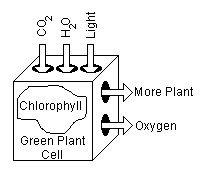 This is
an illustration of the closed box approach to photosynthesis:
This is
an illustration of the closed box approach to photosynthesis:
Here is the shorthand equation for the same process:
In this equation the chlorophyll is placed above the arrow because it is necessary for the reaction, but it is not used up in the reaction. It is neither a reactant nor a product, but it acts like a chemical stimulant to the reaction. The chlorophyll causes the reaction to occur. Chemicals of this type are very common in biological systems.
In this reaction (click one):
You are now at a point in your understanding of photosynthesis where you know what materials enter a plant cell and what materials leave a plant cell. You are, in a way, in the position of a person who lives across the street from a small automobile factory. Each day this person sees raw materials such as iron, glass, paint, cloth, and coal enter the factory and sees finished cars leave the factory. The person can live across from the factory all his life and never know what happens inside the factory. The raw materials and the end product may be well known, but the inside of the factory is still a "closed box" for the person.
The raw materials of carbon dioxide, water, and light energy go into the plant, and the finished product of more plant materials exits from the cell along with the waste material of oxygen gas. But what happens inside the cell? What is the role of chlorophyll in the manufacturing process? What does the assembly line for the finished product look like?
This is the end of lesson nine . Click here to go back
to the home page and lesson ten: Photosynthesis- Overview
Part II. click
Created by the Multimedia Development Lab, Academic Technology Services.
Last modified October 29, 1997.